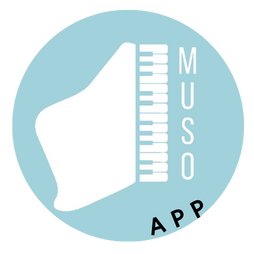Learning music notes can often seem like cracking a complex code but with Muso Method, it becomes an enjoyable and rewarding journey for both students and educators. Whether you’re a parent eager to support your child’s musical adventure or a music teacher seeking to enhance your teaching methods, this blog will offer insight why Muso Flash Cards will help beginners learn note reading in a more meaningful way.
Embrace the Power of Muso Flash Cards:
Muso Flash Cards developed by the Muso Method are a great tried-and-tested method to facilitate visual learning. Over 2000+ beginners have used Muso Flash Cards and we can GUARANTEE their success. These Muso Flash Cards act like a ‘warm up’ before students play pieces and each note is associated with the line position, allowing learners to quickly recognise and memorise music notes. Our Muso Method Flash Cards, specifically designed for durability and child-friendliness, also include a free online course to seamlessly integrate them into your teaching practice.
 |

|
 |
 |
 |
 |
Isabelle Ng is the designer and co-founder of Muso Method. With Psychology background, Isabelle further enhanced the note reading pedagogy with flash cards using the concept of ‘Active Recall and Spaced Repetition’. Active Recalling is essentially engaging the brain and creating meaningful associations to process information better. Spaced Repetition is all about timing, increasing intervals overtime.
Active Recall
Previously, students were taught to simply ‘Memorise’ the answer by using acronyms or unmeaningful difficult relations, or just to ‘memorise with flash cards’. It’s a wonder why students struggle to understand classical music. And funny enough, our younger siblings at Muso Music Academy who learn with Muso Flash Cards have better sight reading skills then our students who used old, plain Muso Flash Cards! This is because we enhanced the meaning and GAMES involved with learning music notes.
Because Muso Method is developed to help younger kids (ironically adults understand it easier too, but this is another point I will make later), we associate each note with a meaningful tip that is super dooper SIMPLE and kid friendly. That way, we can all have some serious fun!

Studies have shown across all educational subjects, students typically learn by memorising information . But with active recall, you learn by actively trying to remember the information. Put simply, it’s the process of searching your brain to find an answer.
Examples of Muso Method active recall games, which we instruct in our Muso Flash Card ‘Instruction Guidelines’ and Muso2Six Free Note Reading online program:
- When your teacher asks you ‘why is this note G’?
- When the parents ask Learner to ‘teacher roleplay’ and get you to ‘explain the difference between E and G’?
- Play activities e.g. ‘Spin and Play’ or ‘Shuffle and Play’
Incorporating Meaningful Associations with Muso Method Structured Approach:
The Muso Method offers a structured approach to learning music notes, breaking down the process into manageable steps. This method introduces specific learning goals for each week and gradually introduces new music notes over a six-week (2 octaves) to 12-week period (4 octaves). Teaching methods like "Say and Repeat," "Say, Play & Explain," and "Compare & Explain" are used to encourage active participation and understanding.
This approach also aligns with the principles of the Kodály Method (which we only heard after creating Muso Method from other international music teachers), which emphasises sequential learning and the use of folk songs to teach musical concepts. Both methods focus on making music education accessible and engaging for students of all ages.
Tasking Meaningful Music Games:
Games are a powerful way to engage students and make learning enjoyable. The Muso Music Academy incorporates games like "Sequence," "Treasure Hunt," and "Note Recognition in 3 Second Challenge" into daily practice routines. These games enhance active recall, memory retention and make the learning process interactive and fun for young kids. To be honest, even adults will find it fun too!
According to educational psychologist Jean Piaget, play is crucial for cognitive development, especially in young children. By framing practice as "Music Games," the Muso Method ensures that learning is both effective and enjoyable.

- Distraction or Playful Games
Spaced Retention
Muso Method has a structured strategic plan in learning notes in gradual intervals, allowing note learning or other music symbols to be retained in the brain’s long term memory storage.
- Week 1 - Learn new cards: Treble Clef, Bass Clef, Middle CDE
- Week 2 - Revise Treble Clef, Bass Clef, Middle CDE. Learn new cards: Treble Clef FG
- Week 3 - Revise previous cards. Learn new cards: Treble Clef ABC
- Week 4 - Revise previous cards. Learn new cards: Bass Clef CBA
- Week 5 - Revise previous cards. Learn new cards: Bass Clef GF
- Week 6 - Revise previous cards. Learn new cards: Bass Clef EDC
Check out another one of our blogs about our 6- Week Challenge and learn about our really fun and engaging way our students learn music notes FAST!
How to read 2 octaves of music notes in 6 weeks! [Using Muso Flash Cards]
Benefits of Muso Flash Cards Summary
- Saves time
- Reduced Cognitive Load
- Deep Understanding
- Retention
Spotlight on the Muso Method Flash Cards:
The Muso Method Flash Cards stand out for their innovative design and educational impact. Splash-proof and robust, they are built to withstand the rigours of classroom use. Designed to look and feel like a game, they transform the learning experience into something children look forward to.
Really helpful for teaching!

The easiest way to learn music notes is through a holistic approach that combines various methods to create an engaging and comprehensive learning experience. By using flash cards, playing games, following a structured method like the Muso Method, practising regularly, attending classes, and utilising online resources, students can master music notes with ease. For teachers, these strategies can enhance their teaching practices, making music education more effective and enjoyable. Remember, patience and consistency are key.
Happy learning!

